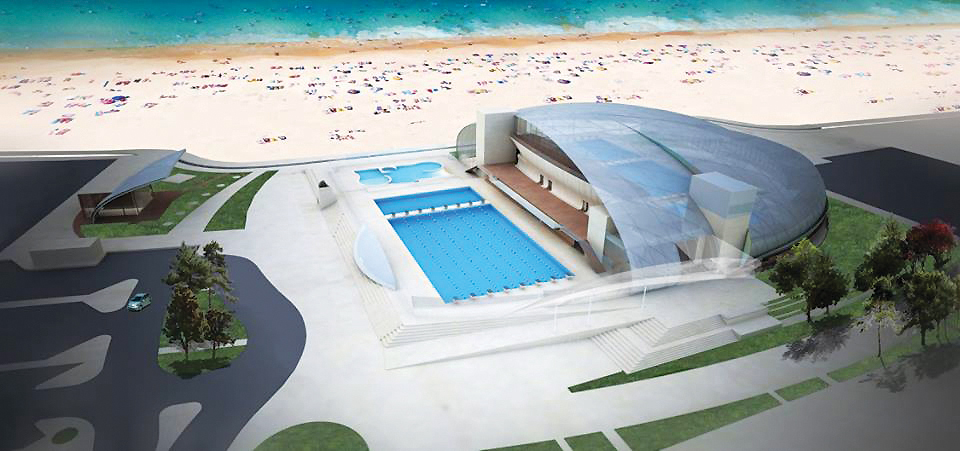Although the California Coastal Commission has made its concerns clear that an anticipated rise in sea level a century from now may preclude a proposed redesign of the new Belmont Olympic Plaza Pool, City of Long Beach and commission officials have not yet finalized a new proposal.
Delayed by a lawsuit and the rejection of its initial design proposal, city staff are revisiting the proverbial drawing board to create a new plan that meets the Coastal Commission’s standards, reduces the cost of the project and maintains the location of the site, according to Assistant City Manager Tom Modica.
The city’s process could take at least 18 months, factoring in collaborations with the commission and independently finalizing a design for the Belmont Pool. The commission is responsible for approving permits for public-trust lands, which is the case for the proposed site at 4000 E. Olympic Plaza.

The original pool, built in 1968, was demolished in 2014 due to seismic concerns. In 2017, the Long Beach City Council approved a project for a new state-of-the-art facility that would replace the original pool. Although Modica noted that this proposal accounted for sea-level rise and considered alternate locations, the Coastal Commission is seeking to move the project as far from the coast as possible. The commission cited recent studies that show drastic rises in sea level by the year 2100.
The commission is troubled about the potential of a 100-year storm, which is the probability of intense wave uprush – stemming from strong storm activity within the century – that can cause severe flooding along the coast, effectively inundating part of the future pool site.
“We’ve done a number of studies to see what sea-level rise will be, and the guidance that the Coastal Commission wants us to use is the 2100 projections – which is about . . . 175 centimeters of sea-level rise,” Modica told the Business Journal. “And there’s about a 1% chance of that happening, of that level amount happening for the project. If that were to occur . . . then it would be kind of touching one corner of the project as proposed.”
Sarah Christie, a spokesperson for the California Coastal Commission, said in a phone interview that, in addition to the project’s close proximity to the coast, officials were concerned about its height, which she said would likely require a local-coast permit (LCP) amendment to approve.
“A lot of people appealed to the Coastal Commission,” Christie said. “The permit hasn’t been submitted to us yet [by the city], so we don’t really have a timeline, because the clock doesn’t start until we get the completed permit application. [The city] already waived the timeline on the appeal. . . . Ultimately, we’ll come to some kind of mutual agreement, and then it will move forward.”
Modica said the city has considered a beach nourishment program to combat erosion and increase beach width in order to compromise with the Coastal Commission and maintain the project’s location. Other solutions involve organizing future activities at the pool further from the coast.
“The preferred site . . . that the city believes is the best is the current one,” Modica said. “The Coastal Commission is asking questions about that, so we need to make sure we’re showing them that this really is a superior site for the project. So, what we’re talking about is . . . can we look at ways to move some of the programming away from the beach and move it further north.”
Currently, there is no deadline or timeline for when the updated design will be completed or presented to the Coastal Commission.
The project, to be funded by the city’s Tidelands Fund, is approaching a cost of $145 million, Modica said. The city is mulling design adjustments to bring the price down to about $80 million, since increasing tariffs on steel imports have affected the cost of the project. Modica said the city has $61.5 million already set aside for the project from the Tidelands Fund, meaning that additional sources of revenue may be necessary.
The city also intends on making the future site a “regional asset” by serving the Southern California region through recreational programs targeted at disadvantaged youth. “[It would] really connect communities that wouldn’t typically go to that pool [and let them] know that’s an amazing facility,” Modica said. “They’re welcome there, [it’ll] be available to the entire city, and hopefully they’ll keep coming back with their families.”
In 2018, Long Beach Mayor Robert Garcia announced the “8 by 28” initiative to complete eight projects by 2028, when the Olympic Games will be hosted in Los Angeles County, including areas of Long Beach. Garcia identified the reconstruction of the Belmont Olympic Plaza Pool as one of the projects he hoped to complete by 2028.
In an email to the Long Beach Business Journal, 3rd District Councilmember Suzie Price remained optimistic about the project’s progress.
“I remain engaged and very supportive of this project and look forward to a project that will meet the needs of the community, as well as address the concerns of the Coastal Commission,” Price said. “I look forward to the next steps and am grateful that city staff has been working diligently over the past three years to get us this far with the permitting agency and stakeholders.”
